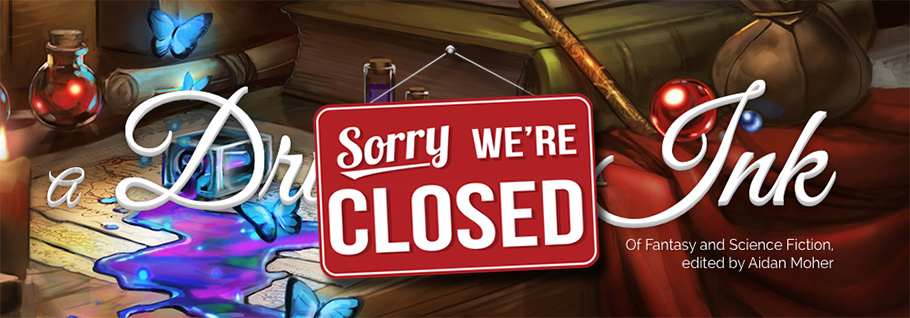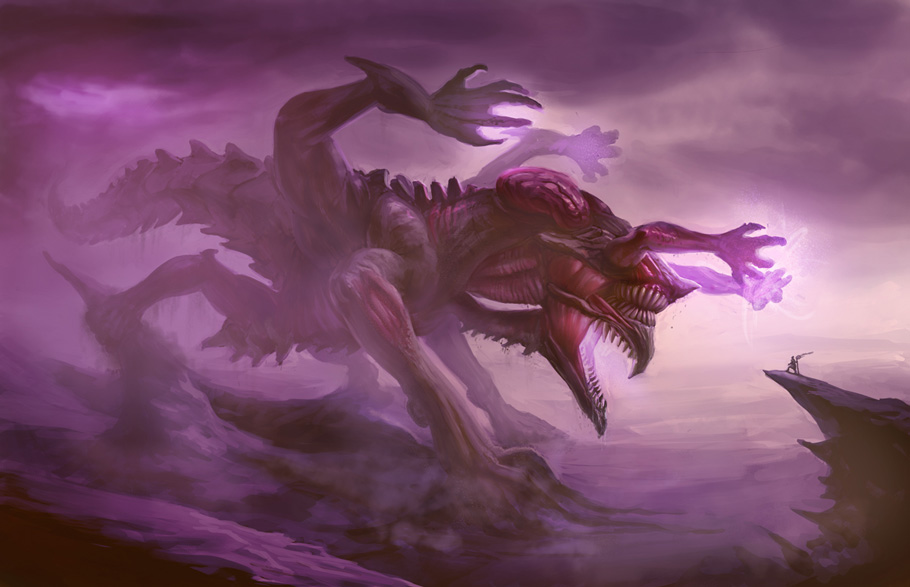
It is with an equal helping of bittersweet melancholy and bright-eyed excitement that I am announcing the closure of A Dribble of Ink today.
A Dribble of Ink first opened in 2007, when I was a freshly graduated web development student, and in the intervening years has turned into the most passionate and rewarding professional and personal project of my life so far. The energy and enthusiasm I poured into A Dribble of Ink was rewarded in 2014 when I won a Hugo Award for “Best Fanzine,” an accolade that’s still sinking in, and in the many, many people who have read and commented on the news bits, reviews, interviews, essays, and more that have been posted here.
However, in the past year, since the birth of my daughter and the release of my first book, Tide of Shadows and Other Stories, my personal and professional goals have begun to find themselves at odds with the time and attention it takes to run an SFF publication to the standard I expect of myself and A Dribble of Ink. I want to focus more on writing fiction and, even more so, on spending time with my growing family. Read More »
Juxtaposition is one of the most powerful tools in a writer’s arsenal
One of my favourite novels is Cao Xuequin and Gao E’s Dream of Red Mansions, which has nothing we would recognise as a plot by modern standards: it follows the “twelve beauties of Jinling”, the main characters of a decaying household in China under the Qing dynasty; and juxtaposes and contrasts their experiences to achieve a powerful and moving tapestry of narratives that speak both to the female and human experience.
This act of juxtaposition is one of the most powerful tools in a writer’s arsenal, and one that I’m particularly affectionate towards. A common example is dichotomies for characters: X being a foil for protagonist Y, or the opposites antagonist/protagonist, hero/villain. I prefer to think of it in terms of contrasts, to decentre the story—I go for moral ambiguity very often, and therefore my fiction tends to function in terms of POV characters rather than heroes. Read More »
Previously on “Anatomy of a Sale,” I made my first short story sale and then had no luck for almost five months. But then I made sale after sale after sale, I got an anthology invite, and I was asked to be Assistant Editor of a magazine. Things were happening!
And then nothing happened for a couple months.
Draft 1: 6/5/2014
Draft 2: 1/5/2015
Final (Draft 6): 2/9/2015
Submission: 89
Rejections: 2 (80 lifetime, 2 from this market)
Rewrite Request: 4/20/2015 (30 days)
Resubmission: 4/25/2015
Acceptance: 4/28/2015 (38 days)
Draft 1 to Sale: 327 days
Final to Sale: 78 days
Last June several of us Bay Area writers formed a small community on Twitter, dubbed #baywriters by Christie Yant (who is not in the Bay Area but is generally a positive influence on writers). We organized writing sprints, and one night when we were getting ready to write 1000 words in half an hour, I asked for a prompt. I got this.
Sometimes a bizarre Twitter prompt turns into a silly story about a psychic alligator, and sometimes it turns into an emotionally devastating story about a woman in a post-apocalyptic diner. I cranked out a first draft (826 words) that night.
And then I didn’t touch it for six months. I worked on other projects, but in the back of my head, I knew that I had a viable, compelling piece there that I wanted to revise one day. Normally I don’t wait so long to revise because it can be hard to recapture the voice and the world, and I may have lost my initial grip on the narrative, but I was very pleased to be able to come back to this piece in January and whip it into shape over the course of a month.
“Marcie’s Waffles Is the Best in Town” is my fastest sale since my first, selling on its third time out, and it illustrates what I was saying above about personal rejections. Read More »
On September 12, 2013, I declared in front of God and Facebook that by that time next year, I was going to be a published author. Ten months later, I made my first short story sale (at pro rates), and since then I’ve made eight more, all but one to pro markets. There are a number of factors to which I could attribute my rapid success—one being that I have been writing for decades, I simply had not been submitting to SFF markets, so my craft was fairly well honed by that point—but the most important, in my opinion, was that I received advice from more seasoned writers on how and where to submit. In fact, one reason I even decided to try my hand at becoming published was because the SFF community is so supportive of new authors, and I knew I had a network of people to show me the ropes. And show me they did.
Now, I am hardly seasoned (I just got here! is my constant refrain), but I want to be a knowledge conduit. In this post I will examine each one of my sales and provide statistics and numbers, dissecting the process to extract vital information that you can use in your own career. But more than that, I hope that my experience can be both inspiring and comforting: a bibliography does not tell you how many times a story was rejected, how long a story took to sell from its inception (either idea or first draft), how many submissions the writer made. If you are a new writer, if you are about to begin submitting to magazines, you should be aware of these things. I made my first submission in December 2013, but I did not begin submitting in earnest until March since, well, I didn’t have more things to submit! Since then, however, I’ve been submitting constantly. Come with me as I break down the mystery. Read More »
Gary Whitta might best be known as a screenwriter–penning popular science fiction films such as The Book of Eli and the upcoming Star Wars spin-off, Star Wars Anthology: Rogue One, but the former EIC of PC Gamer magazine is a novelist, too. His first book, Abomination, officially hit store shelves today. “[It’s a] bloody, unapologetic fantasy,” says Chuck Wendig, popular SFF blogger and author of Aftermath: Star Wars, this is history twisted by the hands of a master storyteller.”
But Abomination is remarkable for more than just the words between its pages, but also its road to publication, via Inkshares, a new publisher who offer authors a unique way to engage with their audience.
I caught up with Whitta to chat about his new novels, Inkshares, and what he learned from writing a Star Wars film. Read More »





